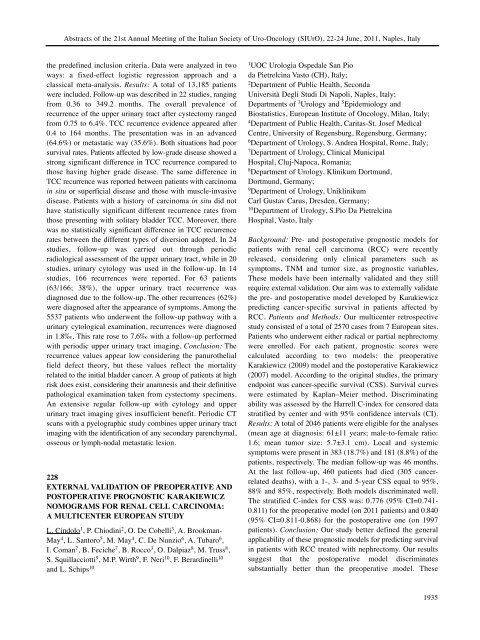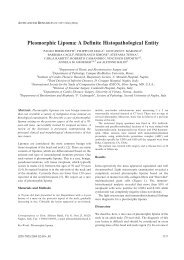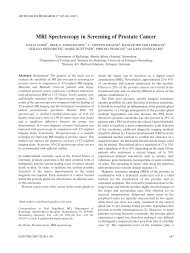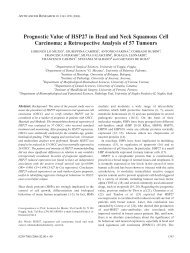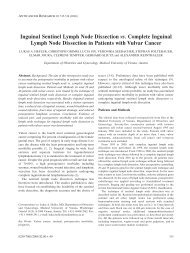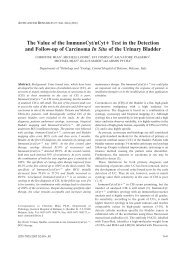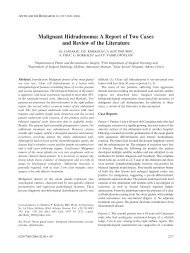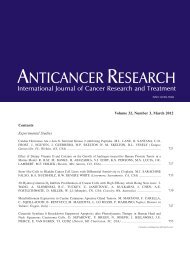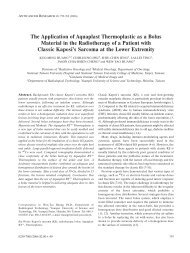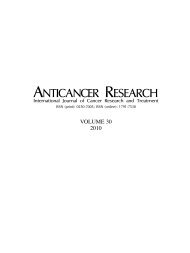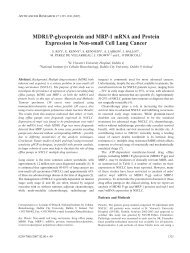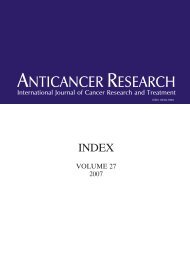ABSTRACTS OF THE 21st ANNUAL MEETING OF THE ITALIAN ...
ABSTRACTS OF THE 21st ANNUAL MEETING OF THE ITALIAN ...
ABSTRACTS OF THE 21st ANNUAL MEETING OF THE ITALIAN ...
You also want an ePaper? Increase the reach of your titles
YUMPU automatically turns print PDFs into web optimized ePapers that Google loves.
Abstracts of the <strong>21st</strong> Annual Meeting of the Italian Society of Uro-Oncology (SIUrO), 22-24 June, 2011, Naples, Italy<br />
the predefined inclusion criteria. Data were analyzed in two<br />
ways: a fixed-effect logistic regression approach and a<br />
classical meta-analysis. Results: A total of 13,185 patients<br />
were included. Follow-up was described in 22 studies, ranging<br />
from 0.36 to 349.2 months. The overall prevalence of<br />
recurrence of the upper urinary tract after cystectomy ranged<br />
from 0.75 to 6.4%. TCC recurrence evidence appeared after<br />
0.4 to 164 months. The presentation was in an advanced<br />
(64.6%) or metastatic way (35.6%). Both situations had poor<br />
survival rates. Patients affected by low-grade disease showed a<br />
strong significant difference in TCC recurrence compared to<br />
those having higher grade disease. The same difference in<br />
TCC recurrence was reported between patients with carcinoma<br />
in situ or superficial disease and those with muscle-invasive<br />
disease. Patients with a history of carcinoma in situ did not<br />
have statistically significant different recurrence rates from<br />
those presenting with solitary bladder TCC. Moreover, there<br />
was no statistically significant difference in TCC recurrence<br />
rates between the different types of diversion adopted. In 24<br />
studies, follow-up was carried out through periodic<br />
radiological assessment of the upper urinary tract, while in 20<br />
studies, urinary cytology was used in the follow-up. In 14<br />
studies, 166 recurrences were reported. For 63 patients<br />
(63/166; 38%), the upper urinary tract recurrence was<br />
diagnosed due to the follow-up. The other recurrences (62%)<br />
were diagnosed after the appearance of symptoms. Among the<br />
5537 patients who underwent the follow-up pathway with a<br />
urinary cytological examination, recurrences were diagnosed<br />
in 1.8‰. This rate rose to 7.6‰ with a follow-up performed<br />
with periodic upper urinary tract imaging. Conclusion: The<br />
recurrence values appear low considering the panurothelial<br />
field defect theory, but these values reflect the mortality<br />
related to the initial bladder cancer. A group of patients at high<br />
risk does exist, considering their anamnesis and their definitive<br />
pathological examination taken from cystectomy specimens.<br />
An extensive regular follow-up with cytology and upper<br />
urinary tract imaging gives insufficient benefit. Periodic CT<br />
scans with a pyelographic study combines upper urinary tract<br />
imaging with the identification of any secondary parenchymal,<br />
osseous or lymph-nodal metastatic lesion.<br />
228<br />
EXTERNAL VALIDATION <strong>OF</strong> PREOPERATIVE AND<br />
POSTOPERATIVE PROGNOSTIC KARAKIEWICZ<br />
NOMOGRAMS FOR RENAL CELL CARCINOMA:<br />
A MULTICENTER EUROPEAN STUDY<br />
L. Cindolo 1 , P. Chiodini 2 , O. De Cobelli 3 , A. Brookman-<br />
May 4 , L. Santoro 5 , M. May 4 , C. De Nunzio 6 , A. Tubaro 6 ,<br />
I. Coman 7 , B. Feciche 7 , B. Rocco 3 , O. Dalpiaz 8 , M. Truss 8 ,<br />
S. Squillacciotti 9 , M.P. Wirth 9 , F. Neri 10 , F. Berardinelli 10<br />
and L. Schips 10<br />
1UOC Urologia Ospedale San Pio<br />
da Pietrelcina Vasto (CH), Italy;<br />
2Department of Public Health, Seconda<br />
Università Degli Studi Di Napoli, Naples, Italy;<br />
Departments of 3Urology and 5Epidemiology and<br />
Biostatistics, European Institute of Oncology, Milan, Italy;<br />
4Department of Public Health, Caritas-St. Josef Medical<br />
Centre, University of Regensburg, Regensburg, Germany;<br />
6Department of Urology, S. Andrea Hospital, Rome, Italy;<br />
7Department of Urology, Clinical Municipal<br />
Hospital, Cluj-Napoca, Romania;<br />
8Department of Urology, Klinikum Dortmund,<br />
Dortmund, Germany;<br />
9Department of Urology, Uniklinikum<br />
Carl Gustav Carus, Dresden, Germany;<br />
10Department of Urology, S.Pio Da Pietrelcina<br />
Hospital, Vasto, Italy<br />
Background: Pre- and postoperative prognostic models for<br />
patients with renal cell carcinoma (RCC) were recently<br />
released, considering only clinical parameters such as<br />
symptoms, TNM and tumor size, as prognostic variables.<br />
These models have been internally validated and they still<br />
require external validation. Our aim was to externally validate<br />
the pre- and postoperative model developed by Karakiewicz<br />
predicting cancer-specific survival in patients affected by<br />
RCC. Patients and Methods: Our multicenter retrospective<br />
study consisted of a total of 2570 cases from 7 European sites.<br />
Patients who underwent either radical or partial nephrectomy<br />
were enrolled. For each patient, prognostic scores were<br />
calculated according to two models: the preoperative<br />
Karakiewicz (2009) model and the postoperative Karakiewicz<br />
(2007) model. According to the original studies, the primary<br />
endpoint was cancer-specific survival (CSS). Survival curves<br />
were estimated by Kaplan–Meier method. Discriminating<br />
ability was assessed by the Harrell C-index for censored data<br />
stratified by center and with 95% confidence intervals (CI).<br />
Results: A total of 2046 patients were eligible for the analyses<br />
(mean age at diagnosis: 61±11 years; male-to-female ratio:<br />
1.6; mean tumor size: 5.7±3.1 cm). Local and systemic<br />
symptoms were present in 383 (18.7%) and 181 (8.8%) of the<br />
patients, respectively. The median follow-up was 46 months.<br />
At the last follow-up, 460 patients had died (305 cancerrelated<br />
deaths), with a 1-, 3- and 5-year CSS equal to 95%,<br />
88% and 85%, respectively. Both models discriminated well.<br />
The stratified C-index for CSS was: 0.776 (95% CI=0.741-<br />
0.811) for the preoperative model (on 2011 patients) and 0.840<br />
(95% CI=0.811-0.868) for the postoperative one (on 1997<br />
patients). Conclusion: Our study better defined the general<br />
applicability of these prognostic models for predicting survival<br />
in patients with RCC treated with nephrectomy. Our results<br />
suggest that the postoperative model discriminates<br />
substantially better than the preoperative model. These<br />
1935


